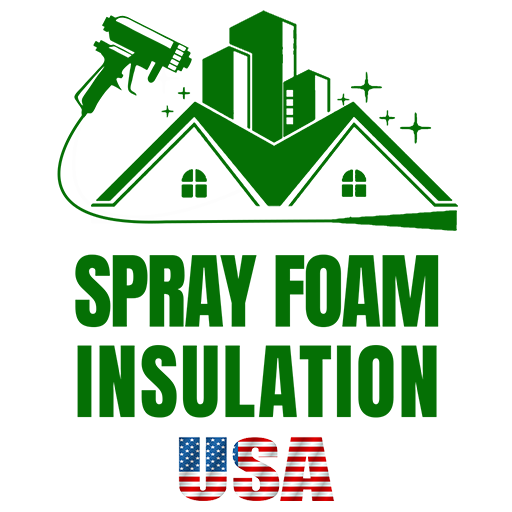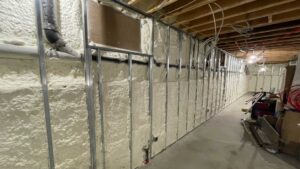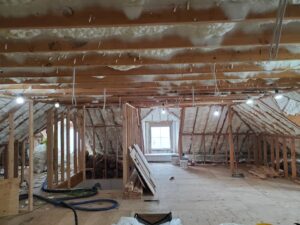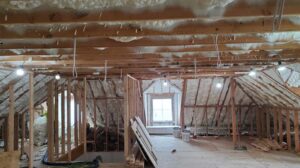Quick Guide to Advanced Insulation Solutions:
- Insulation is Key: Keeps your home or business comfortable, reduces energy bills.
- Energy Efficiency: The right insulation can save you a lot by requiring less heating or cooling.
- Go Green: Choosing eco-friendly insulation contributes to a healthier planet.
Insulation isn’t just about staying warm in winter or cool in summer. It’s about creating an energy-efficient, comfortable space that saves you money and is good for the planet. Whether you’re a homeowner in New York or a business owner in New Jersey, finding the right insulation is crucial for your space’s comfort and your wallet.
Advanced insulation solutions come in many forms, from spray foam that seals leaks to fiberglass that’s easy on the wallet, catering to different needs and spaces. Technology like closed-cell foam offers incredible insulation and moisture resistance, while materials like blown-in fiberglass can get into those hard-to-reach places, ensuring your space is covered from top to bottom.
Understanding which insulation is best for your home or business doesn’t have to be complicated. Let’s dive into advanced insulation, breaking down the pros and cons of each type so you can make an informed decision. The goal? Energy efficiency, year-round comfort, and a lower carbon footprint.

Understanding Insulation Solutions
When exploring advanced insulation solutions, it’s crucial to understand the different types available and their respective benefits and drawbacks. This knowledge will empower you to make choices that align with your needs for energy efficiency, comfort, and air sealing in your home or commercial space.
Closed Cell Foam
Closed cell foam is a heavyweight in the insulation arena. It’s known for its high R-value, which translates to superior resistance to the movement of heat. This type of foam is dense, adding structural strength to walls where it’s applied.
Benefits:
– High R-value: Provides excellent thermal resistance.
– Moisture Barrier: Resists water, reducing the risk of mold and mildew.
– Adds Strength: Can enhance the structural integrity of the building.
– Air Seal: Minimizes air leakage, enhancing energy efficiency.
Drawbacks:
– Cost: It’s more expensive compared to other insulation types.
– Installation: Requires professional installation; not a DIY-friendly option.
– Rigidity: Its stiffness may not be suitable for all spaces.
Open Cell Foam
On the softer side, we have open cell foam. This type is lighter and more flexible, making it easier to install in tricky, hard-to-reach areas. It’s particularly effective for soundproofing, making it a popular choice for homes and businesses alike.
Benefits:
– Soundproofing: Excellent for reducing noise pollution.
– Flexibility: Easily fills nooks, crannies, and irregular spaces.
– Air Sealing: Provides a continuous air barrier for better energy efficiency.
– Comfort: Enhances indoor comfort by maintaining consistent temperatures.
Drawbacks:
– Lower R-value: While still effective, it offers lower thermal resistance compared to closed cell foam.
– Moisture Permeability: More susceptible to moisture, which could lead to potential issues in damp environments.
– Durability: Less rigid and may not add structural strength to the building.
Air Sealing and Comfort:
Both types of foam play a crucial role in air sealing, a process that prevents unwanted air exchange between the inside and outside of a building. Proper air sealing can significantly reduce energy costs and improve indoor air quality.
- Closed cell foam excels in providing a moisture-resistant barrier, making it ideal for areas prone to water exposure.
- Open cell foam, with its superior soundproofing capabilities, can drastically improve the acoustic comfort of a space, making it quieter and more serene.
In summary, understanding the differences between closed cell and open cell foam insulation is key to selecting the right advanced insulation solution for your project. Each has its unique set of benefits and drawbacks, tailored to different needs and preferences. Whether your priority is energy efficiency, moisture resistance, structural strength, soundproofing, or air sealing, there’s an insulation solution that fits the bill.
As we continue to explore innovative insulation techniques and materials in the following sections, keep in mind these foundational insights to guide your decisions towards achieving maximum efficiency and comfort in your insulated spaces.
Advanced Insulation Materials
When it comes to keeping our homes and buildings energy-efficient and safe, the materials we choose play a crucial role. Let’s dive into some advanced insulation solutions that have been making waves in the industry.
Spray Foam Insulation
Spray Foam Insulation, particularly ICYNENE, stands out for its ability to act as both an insulator and an air barrier. This dual function means it can keep your space warm or cool while stopping unwanted air movement. This is a big deal because when air moves in and out of a building, it can lead to higher energy bills. Spray foam insulation addresses this problem head-on by filling every nook and cranny, creating a seal that traditional materials can’t match.
The beauty of spray foam lies in its versatility. It can be used in various parts of a building, from the roof down to the foundation, making it a one-stop solution for many insulation needs. Plus, with options like open-cell and closed-cell foam, it offers solutions tailored to different requirements regarding moisture resistance and R-value—a measure of insulation’s ability to resist heat flow.
Passive Fire Protection
Safety is paramount, and that’s where passive fire protection comes into play. Materials designed for this purpose, such as underdeck and explosion protection systems, are crucial for minimizing damage and maintaining structural integrity in the event of a fire or explosion. These systems don’t just protect the building; they safeguard the lives of those inside.
For instance, underdeck systems are designed to reduce the risk of fires spreading between floors, while explosion protection materials are engineered to absorb and mitigate the impact of blasts, protecting both the structure and its occupants. This level of protection is invaluable in commercial settings where the risk of fire and explosions can be higher.
Thermal Insulation Solutions
When dealing with high-temperature environments, such as exhausts and turbines, standard insulation materials might not make the cut. This is where advanced thermal insulation solutions come into play. Materials developed by companies like SAES Getters and GrafTech are designed to withstand extreme temperatures, ensuring that machinery operates efficiently and safely.
These high-temperature insulation solutions are not just about resisting heat. They also play a critical role in energy efficiency. By keeping heat contained within systems like turbines and exhausts, they reduce energy waste, leading to lower operating costs and a smaller environmental footprint.
In conclusion, advanced insulation materials is vast and varied. From spray foam insulation that offers exceptional energy efficiency and air sealing capabilities, to passive fire protection that keeps buildings and their occupants safe, to thermal insulation solutions designed for the most demanding environments—there’s an advanced material for nearly every need. As we move towards more sustainable and energy-efficient building practices, these advanced materials are set to play a pivotal role.
Innovative Insulation Techniques
In the realm of building and construction, staying ahead means not just adopting the latest technologies but also integrating innovative techniques that enhance the performance and sustainability of structures. Among these, advanced insulation solutions stand out for their ability to address a wide array of challenges, from energy efficiency to noise pollution and corrosion under harsh conditions. Let’s dive into how these innovative techniques are changing the game.
Acoustic Protection
In today’s bustling world, the quest for tranquility within our living and working spaces has never been more critical. Advanced insulation solutions offer remarkable noise reduction capabilities, acting as a barrier that absorbs sound vibrations and prevents them from permeating through walls, floors, and ceilings. This is not just about creating a quiet environment; it’s about enhancing the quality of life and productivity by minimizing distractions and stress caused by unwanted noise.
One standout example is the use of Spray Foam Insulation, which, due to its expansive nature, fills up cavities and cracks, significantly reducing sound transmission. This technique not only insulates but also serves as an effective vibration control mechanism, dampening the vibrations caused by external noises or even machinery within buildings.
Corrosion Protection
For structures exposed to offshore conditions or harsh environments, corrosion protection is paramount to maintain structural integrity over time. Advanced insulation materials are specifically engineered to withstand such conditions, providing a protective shield against moisture, saltwater, and chemicals that can lead to corrosion.
ContraFlex® jackets, for example, are custom-designed covers that not only offer thermal insulation but also protect against the harsh marine environment, ensuring the longevity of the underlying structure or equipment. This dual functionality highlights the innovative approach to tackling multiple challenges with a single solution.
Active Insulation
Moving beyond traditional passive insulation, active insulation represents a leap forward in building technology. This dynamic system utilizes materials like phase-change materials (PCMs), which adjust their thermal properties in response to changes in temperature. By absorbing excess heat when it’s warm and releasing it when it’s cool, active insulation helps maintain a consistent indoor environment, greatly enhancing energy efficiency.
Energy Audits and HERS Index
To truly optimize a building’s performance, energy audits play a crucial role. These assessments help identify where and how energy is being lost, allowing for targeted improvements. Coupled with the Home Energy Rating System (HERS) Index, which quantifies a home’s energy efficiency, homeowners and builders can make informed decisions about implementing advanced insulation solutions to reduce energy consumption and costs.
By integrating these innovative insulation techniques, from acoustic protection that shields us from the chaos of the outside world, to corrosion protection that ensures the longevity of our infrastructure, and active insulation that dynamically responds to our climate needs, we are not just building structures. We are crafting environments that enhance our well-being, protect our investments, and safeguard our planet for future generations.
As we continue to explore and implement these advanced solutions, the potential for creating more sustainable, efficient, and comfortable spaces is limitless. With companies like Spray Foam Insulation USA leading the charge, the future of insulation is bright, filled with possibilities for innovation and improvement.
Insulation for Specific Needs
In the vast world of building and construction, every project comes with its unique set of challenges and requirements. This is especially true when it comes to insulation. Whether it’s a cozy home, a sprawling commercial building, or a specialized custom freezer, each demands a tailored approach to ensure maximum energy savings, comfort, and efficiency. Let’s delve into how advanced insulation solutions cater to these diverse needs.
Residential Insulation Contractors
For homeowners, the journey to an energy-efficient and comfortable living space starts with the right insulation. Residential insulation contractors play a pivotal role in this process. By employing advanced insulation solutions like spray foam, they can significantly reduce energy bills while enhancing indoor comfort, regardless of the season.
Imagine a winter without the chill seeping through the walls or a summer where the cool air stays where it’s supposed to be. That’s the power of effective insulation. It’s not just about saving on energy costs; it’s about creating a home environment where comfort is a constant, and energy waste is minimized.
Commercial Insulation Installations
When it comes to commercial buildings, the stakes are higher. These structures are not just larger; they often have complex HVAC systems and varying occupancy patterns. This complexity requires a nuanced approach to insulation, one that considers architecture handling and aims for significant energy bill reduction.
Commercial insulation installations focus on creating a consistent temperature across vast spaces, adhering to stringent fire safety and energy codes, and optimizing the building’s overall performance. The goal is to strike a balance between operational efficiency and occupant comfort, ensuring that businesses can thrive in an environment that’s cost-effective and energy-efficient.
Custom Freezers
Specialized insulation solutions extend beyond the realms of residential and commercial buildings into areas like custom freezers. Here, the focus shifts to preventing heat exchange and maintaining precise temperature conditions. Advanced insulation materials and techniques ensure that these units can operate efficiently, safeguarding perishable goods without skyrocketing energy costs.
It’s a testament to the versatility of advanced insulation solutions. Whether it’s keeping a home warm, ensuring a commercial building is energy-efficient, or maintaining the cold in a custom freezer, the right insulation makes all the difference.
By addressing the specific needs of residential and commercial projects, as well as specialized applications like custom freezers, advanced insulation solutions like those offered by Spray Foam Insulation USA not only lead to significant energy savings and comfort improvement but also contribute to architecture handling and energy bill reduction. As we move towards a future where efficiency and sustainability are paramount, the role of tailored insulation solutions becomes increasingly crucial.
Frequently Asked Questions about Advanced Insulation Solutions
What is the difference between open cell and closed cell foam insulation?
When we talk about advanced insulation solutions, two types often come up: open cell and closed cell foam insulation. Here’s the simple breakdown:
-
Open Cell Foam: Think of it like a sponge. It’s lighter, more flexible, and can absorb sound, making it great for noise reduction. Its R-value (a measure of thermal resistance) is typically around R-3.7 per inch. Because it’s air-filled, it’s not a water vapor barrier. This makes it ideal for indoor spaces where moisture control isn’t a big concern.
-
Closed Cell Foam: This one’s more like a hard, solid plastic. It’s denser, offers higher R-values up to R6.8 per inch, and acts as both an air and moisture barrier. Its strength adds to the structural integrity of the building. Closed cell foam is suitable for both indoor and outdoor applications, offering superior moisture resistance and energy efficiency.
How does active insulation enhance energy efficiency in buildings?
Active insulation takes energy efficiency to the next level. Unlike traditional materials that passively resist temperature flow, active insulation systems can adapt to environmental conditions. They work by dynamically adjusting insulation properties, such as thickness or thermal conductivity, in response to temperature changes or energy demand. This adaptability means buildings aren’t just insulated; they’re intelligently responding to keep energy usage at a minimum. For instance, during a cold night, the insulation could increase its thermal resistance, keeping heat in. On a sunny day, it might reduce resistance, allowing natural warmth to reduce heating needs.
What are the benefits of using advanced insulation materials?
The benefits of opting for advanced insulation materials are vast and varied:
-
Energy Efficiency: High-performance materials like spray foam offer superior R-values, reducing the amount of energy needed to heat or cool buildings. This leads to significant savings on energy bills.
-
Comfort: Advanced solutions create a more consistent indoor temperature, eliminating drafts and cold spots. This means a cozier living or working environment year-round.
-
Sustainability: Many advanced materials are made with eco-friendly practices in mind, contributing to a smaller carbon footprint. Plus, energy savings mean reduced greenhouse gas emissions.
-
Durability: High-quality insulation options are designed to last, maintaining their performance over time and reducing the need for replacements.
-
Healthier Indoor Air: By sealing off outdoor pollutants and moisture, advanced insulation can improve indoor air quality, making spaces healthier to live and work in.
In summary, advanced insulation solutions like those offered by Spray Foam Insulation USA not only lead to significant energy savings and comfort improvement but also contribute to architecture handling and energy bill reduction. As we move towards a future where efficiency and sustainability are paramount, the role of tailored insulation solutions becomes increasingly crucial.
Conclusion
In wrapping up our comprehensive guide on advanced insulation solutions, it’s clear that the choices we make today in insulating our homes and commercial spaces have far-reaching implications. At Spray Foam Insulation USA, we’re not just providing insulation; we’re offering a pathway to a more sustainable, efficient future.
Our commitment to sustainability is evident in every project we undertake. By utilizing the latest in spray foam technology, we ensure that our clients enjoy the benefits of a well-insulated space that keeps energy costs low and comfort high. This isn’t just about saving money on your energy bills — it’s about taking a step towards reducing our carbon footprint and making a positive impact on the environment.
Maximum efficiency is at the heart of what we do. Our spray foam solutions provide an air-tight seal, eliminating the energy wastage that is all too common with less advanced insulation methods. With our products, heating and cooling systems work more efficiently, further reducing energy consumption and extending the lifespan of these systems.
But what truly sets us apart is our dedication to providing sustainable solutions. We understand that the choices we make today affect our planet tomorrow. That’s why our spray foam insulation is designed to be not just incredibly effective, but also environmentally friendly. By choosing Spray Foam Insulation USA, you’re not just insulating your space; you’re contributing to a greener, more sustainable world.
In conclusion, the journey towards a more energy-efficient and comfortable living space is both exciting and essential. With Spray Foam Insulation USA, you have a partner committed to excellence, sustainability, and efficiency. Our advanced insulation solutions are tailored to meet the unique needs of each space, ensuring maximum performance and minimal environmental impact.
Ready to take the next step towards a more sustainable and energy-efficient home? Discover the advantages of choosing Spray Foam Insulation USA for your insulation needs.
Together, let’s build a greener, more sustainable world, one insulated space at a time.






